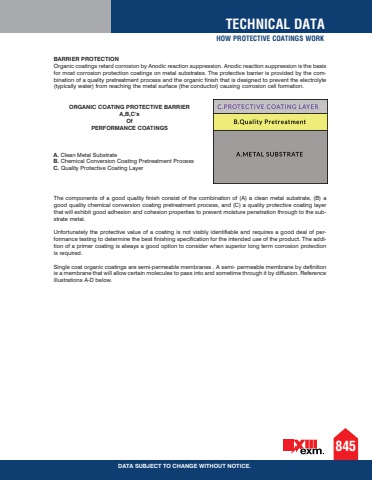Page 877 - Demo
P. 877
845TECHNICAL DATADATA SUBJECT TO CHANGE WITHOUT NOTICE.BARRIER PROTECTIONOrganic coatings retard corrosion by Anodic reaction suppression. Anodic reaction suppression is the basis for most corrosion protection coatings on metal substrates. The protective barrier is provided by the combination of a quality pretreatment process and the organic finish that is designed to prevent the electrolyte (typically water) from reaching the metal surface (the conductor) causing corrosion cell formation.ORGANIC COATING PROTECTIVE BARRIER A,B,C%u2019s Of PERFORMANCE COATINGSThe components of a good quality finish consist of the combination of (A) a clean metal substrate, (B) a good quality chemical conversion coating pretreatment process, and (C) a quality protective coating layer that will exhibit good adhesion and cohesion properties to prevent moisture penetration through to the substrate metal. Unfortunately the protective value of a coating is not visibly identifiable and requires a good deal of performance testing to determine the best finishing specification for the intended use of the product. The addition of a primer coating is always a good option to consider when superior long term corrosion protection is required. Single coat organic coatings are semi-permeable membranes . A semi- permeable membrane by definition is a membrane that will allow certain molecules to pass into and sometime through it by diffusion. Reference illustrations A-D below. A. Clean Metal Substrate B. Chemical Conversion Coating Pretreatment Process C. Quality Protective Coating LayerHOW PROTECTIVE COATINGS WORK


